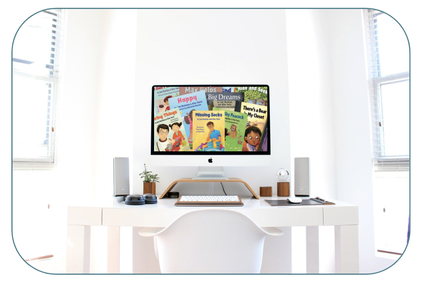|
Sometimes, when we are trying to solve a problem we place limitations on ourselves because of tradition. We don't "think outside of the box" because we have come to consider the box as somehow integral to the process. It helps to sometimes bring to the foreground and scrutinize the barriers that we place on ourselves. So, what is limiting our thinking about guided reading, the trickiest instructional context to shift to digital platforms?
While read aloud, shared reading, and even independent reading and conferences seem to translate to virtual spaces with less disruption to the model, guided reading remains the more challenging instructional context to teach over a computer. In addition to the intrinsic challenge of teaching across cyberspace, the fact that probably no one else has your school district's exact model makes it harder to crowdsource the problems. I am endlessly amazed by all the different ways districts give shape to teaching in 2020 (and soon 2021). In this blog, Hacks for Virtual Guided Reading, I explored some intuitive suggestions for navigating guided reading in virtual spaces, including a suggestion for how to listen to individual students read during virtual guided reading. I recently worked with a school where a teacher was really problem-solving how do just this thing, but she needed a different solution than the one I offered in the previous blog. Her students all had access to district-provided laptops, so that eliminated one barrier that is present for some. In my conversation with the teacher, I realized that we were assuming some pre-virtual conditions that didn't necessarily have to apply. We found that adjusting away from those limitations helped us meet the goal of listening to students read instructional level texts, even though they weren't face to face. Here were some of our assumptions:
As it turns out, none of these assumptions is requisite to guided reading instruction. Questioning all of the aforementioned beliefs, we developed a plan. On Fridays, she is going to give her guided reading groups their texts via links placed on the school's virtual platform. Over the weekend, students will record themselves reading using either video, or simply audio. Students will send their teacher their recordings by Monday. During the week, she will listen to a few student recordings each day, as she had done when guided reading was face-to-face, and take running records. If a student is having difficulty, she will check in with that student via whatever tool seems appropriate. When the group gets together to talk about the book, they can engage in some choral reading of the text and have conversations about it. Again, there are things about this variation on the guided reading model that don't work as well as face-to-face guided reading. You may or may not find out how a child navigates a first-read in a text, although you may be able to specify that you want a first read in the directions. Either way, there are worse problems than a child practicing a text to sound good when they read it to you. If children see their recordings as something to practice and perfect, what we lose in cold-read data we gain in repeated readings practice and reading growth. There remains a driving need to work with small groups in virtual spaces. While none of the creative solutions out there seem to be perfect, many of us are finding that a pandemic is a great time to embrace approximations and explore not being a perfectionist. If you explore this model or some aspect of it, I would love to hear about what you figure out. You can always reach me at [email protected], or you can leave a comment on this post.
5 Comments
Note: If you are in search of the free ebooks for guided reading, go to the "Free Books" tab, above. There are a number of challenges that make teaching guided reading tricky in virtual spaces. From access to books, to watching body language, sound issues, there are definitely some hurdles to get over. As we prepare to go back-to-school, one virtual guided reading challenge is prominent: figuring out how to listen in as individual students read without falling into a round-robin routine.
There is a solution that seems pretty simple. In fact, I think it is so simple that it has been hidden in plain sight. When we are face-to-face during guided reading and listening to individual readers, we want to hear ONLY the reader that is getting our attention, while we conduct a running record or engage in a conversation. Additionally, we don't want the readers who are NOT receiving our attention at that moment to listen in on our exchange with the student in our focus--for their sakes and for the sake of the student who is reading with us. To limit what we hear from the other students we can, of course, mute their microphones. To limit what they hear, we can simply ask them to turn their volume all the way down! This seemingly obvious solution allows us to stay in the group, rather than send students off into breakout rooms, which is clunky. Staying in the group by having the student you are listening to turn up the volume (while the others turn their volume down) allows you to keep that small-group feel to your virtual guided reading lessons. By staying in the group together, you can still watch the other students to see that they are engaged with the text. A little motion on the screen, should get the attention of everyone again. You can use a chat box, or even something as simple as a sign with a student's name on it, to let the group know who needs to turn their volume back up so you can read with the next student. As for access to books, there seem to be a few options.
In the end, shared reading and one-on-one conferring are likely to do more of the heavy-lifting in virtual literacy instruction. However, it is worth trying to figure out how to maintain some small group work for those students who really need it to succeed. Asking the other children to turn down their volume while you work with one child may be one way to make small group instruction work in virtual spaces. |
AuthorDr. Jan Burkins is a full-time writer, consultant, and professional development provider. Categories
All
|


 RSS Feed
RSS Feed